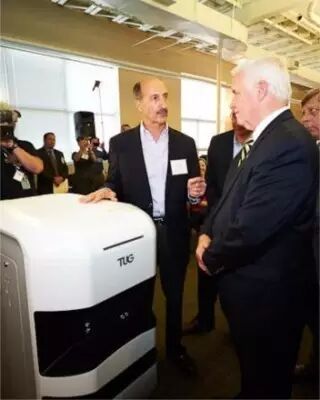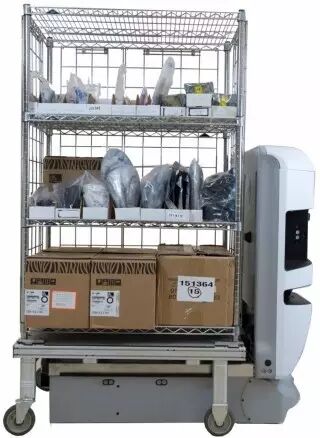Excerpt from Robotics Business Review
Author: RBR Staff
Translation by: Machine Heart
Contributors: Wu Pan, Wang Ziwei
Medical robotics pioneer Aldo Zini explains how Aethon makes its machines safer and more powerful, and he also discusses a common mistake in robotics.
Joanne Pransky, deputy editor of Industrial Robot, recently interviewed Aldo Zini, President and CEO of Aethon. Zini not only developed methods to quantify the value of medical robots but also holds multiple patents related to medication dispensing technology.
While studying for his Bachelor’s degree in Industrial Engineering at the University of Pittsburgh, Zini developed an interest in using automation to make hospitals more efficient.
Later, Zini obtained a Master’s degree in Public Management (Health Systems IT) from Carnegie Mellon University and became the Vice President of Sales and Marketing at Automated Healthcare. The company’s ROBOT-Rx was the first robotic medication dispensing system and was acquired by McKesson for $67 million.
Subsequently, Zini served as Senior Vice President of Sales and Marketing at TechRx. He later generated over $200 million in revenue for medication software provider NDC Corp.
Aethon, based in Pittsburgh, developed the TUG, a mobile autonomous robot with over 450 installations worldwide.
In the interview, Aldo Zini discusses the development history and current status of the TUG robot, providing valuable advice for engineering students.
Pransky: How has the TUG evolved over the years? Can you describe the different versions or major iterations since 2002?
Zini: When we started development, our goal was to create an affordable, reliable, and safe autonomous mobile robot. That was not achieved in 2002-2003. At that time, there were some mobile robots, but they were very expensive, with manufacturing costs reaching hundreds of thousands of dollars; the technology was very complex; it was truly a product that seemed doomed to fail.
Our goal was to simplify and develop a robot that people could afford, which meant it had to have a good return on investment (ROI). That was our initial goal, and then we set out to develop the robot. There were too many unknowns for us in this area, too much for us to learn. We probably didn’t have the first commercial version of the robot until around 2004.
That robot, while it worked reasonably well, had some limitations. Some of these limitations were technical because laser scanners were still very expensive at that time, and cost considerations prevented us from using them. We relied on other sensor modalities—lidar scanners—but they were not as accurate and reliable as laser scanners.
Even though we were able to create an affordable robot, it was not as reliable as we wanted, and it was not safe enough, especially in structured environments like hospitals.

Aldo Zini with Aethon’s TUG robot
Pransky: When was your second iteration, and what modifications were made?
Zini: We made two modifications. One was to make it more reliable and safer, and the other was to add features and characteristics that the market told us they wanted to see in the robot.
In terms of reliability and safety, we developed a modified version of a pattern matching technology for simultaneous localization and mapping (SLAM) to continue creating more robust software. We also increased the number of sonars.
As the costs of laser scanners and other robotic components decreased over time, we were able to integrate more robust sensor modalities with better navigation software. These two things really elevated us to a new level, making the technology very reliable and safe.
Even today, not many people have autonomous mobile robots. This was a very difficult engineering problem we were trying to solve at the time because the robot had to move around hospitals—anywhere in the hospital—opening doors, taking elevators, making 30, 40, 50, sometimes 80 or 90 trips a day, all while surrounded by patients, visitors, doctors, nurses, and clinicians.
We could not afford a mistake. Achieving that level of reliability, accuracy, and safety under so much supervision really took us another four years, at least until 2008, and possibly even 2009, to realize that technology.

The TUG robot has an interchangeable base platform that can carry various carts, trolleys, or cabinets for use in medical or industrial facilities.
Pransky: What new developments are you planning for TUG? What new challenges are you facing?
Zini: For the past two to three years, we have been adding new features to our robots. One challenge we have to overcome is elevators. Elevators around the world are unique; each one is different. We had to develop our own elevator software and our own elevator controllers, which had to be easy to install, operate, and maintain at a low cost. We have invested a lot of work into this.
One feature we are being asked to add, which is becoming very important in the industry, is the ability to automatically grab and unload a cart or container without any infrastructure.
In other words, think of our mobile robot moving to the location of a cart, finding the cart, automatically grabbing it, taking it to where it needs to be delivered, and then automatically placing it there—without any human intervention, without any tracks, beacons, or lines. All autonomous.
This is another huge technological leap because just getting the robot from point A to point B is challenging. But the complexity involved in getting the robot from point A to point B to automatically grab something and then automatically take it somewhere else and place it down has never been accomplished before.
We have successfully implemented this in some locations, including some very large manufacturing sites, and I believe we are currently the only company in the world with this capability. This is a significant achievement, although we are still somewhat limited by the way we are doing this. We are continuing to improve and refine this technology.
Pransky: What is the biggest mistake/lesson you have learned?
Zini: I would say that might be—and I think this is a mistake many people make—we think we know more than we actually do. Until you actually apply your technology to real-world applications, you have not truly completed it. You can develop something in your lab and spend a lot of money and time on it day and night, but unless you really put it in places where people are using it, you really don’t know what you don’t know.
I think an early mistake we made was thinking we had completed certain things, and we were like, “Wow, we did it!” Then when we actually applied it, it didn’t work as we expected. We had to start over. But that was a lesson we learned.
I believe that getting real users—in our case, nurses, doctors, and technicians—to use the technology is what really helps you understand the features and functions of the product, and what you need to provide to create a viable and valuable product. That is something I have learned in my career. You cannot skip that step, and you cannot rush it.
Pransky: How do you think engineering PhD and Master’s students should prepare for commercial robotics in school?
Zini: When I obtained my Master’s degree from Carnegie Mellon University, I had the opportunity to engage with some companies and work on projects with them. I believe I learned more from that than I did from the actual university courses. I advise those pursuing Master’s and PhD degrees to really seek opportunities to work on projects for companies. Many companies accept interns. It is important to go out and see how businesses operate in the real world.
I have seen many engineers who do not understand business operations. They are very focused on technology and want to develop technology as their work.
At Aethon, I often say, “Technology is important, but we want to build a business.” To build a business, you have to think: Is this affordable for people? Is it reliable? Is it safe? Does it solve a problem? What is the actual problem you are solving? Does it provide a good return on investment? How do you market it? How do you sell it? How do you establish a very systematic process, etc.?
I have seen some very good robotics engineers with great ideas, but they do not know how to turn those ideas into a business. They are too focused solely on the technology itself. Going out to see the real world, working with companies, and gaining experience is what I would recommend.
© This article is translated by Machine Heart. For reprint authorization, please contact this public account.
✄————————————————
Join Machine Heart (Full-time Reporter/Intern): [email protected]
Submissions or inquiries: [email protected]
Advertising & Business Cooperation: [email protected]